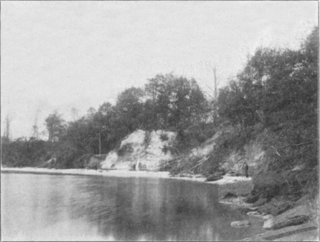| Marshalltown Formation | |
|---|---|
| Stratigraphic range: Middle to late Campanian | |
| Type | Geological formation |
| Underlies | Wenonah Formation |
| Overlies | Englishtown Formation |
The Marshalltown Formation is a Mesozoic geologic formation. Dinosaur remains diagnostic to the genus level are among the fossils that have been recovered from the formation. [1]
Dinosaurs known from the formation: [2] [3]
"Coelosaurus" antiquus is a dubious species of theropod dinosaurs. It was named by Joseph Leidy in 1865 for two tibiae found in the Navesink Formation of New Jersey.
Argiles et Grès à Reptiles Formation also known as the Argiles Rutilantes Formation is an early Maastrichtian French geologic formation in the département of Var preserving the remains of several types of dinosaurs and other extinct organisms.

The Arundel Formation, also known as the Arundel Clay, is a clay-rich sedimentary rock formation, within the Potomac Group, found in Maryland of the United States of America. It is of Aptian age. This rock unit had been economically important as a source of iron ore, but is now more notable for its dinosaur fossils. It consists of clay lenses within depressions in the upper part of the Patuxent Formation that may represent oxbow swamp facies. It is named for Anne Arundel County, Maryland.

The Wayan Formation is a geological formation in Idaho whose strata date back to the latest Early Cretaceous and the earliest Late Cretaceous. Dinosaur, other reptile, mammal, and micro and macro-floral remains are among the fossils that have been recovered from the formation. The lack of extensive outcrops, limited geographic extent, and extreme structural deformation have limited paleontological explorations of the Wayan.
The Continental intercalaire, sometimes referred to as the Continental intercalaire Formation, is a term applied to Cretaceous strata in Northern Africa. It is the largest single stratum found in Africa to date, being between 30 and 800 metres thick in some places. Fossils, including dinosaurs, have been recovered from this formation. The Continental intercalaire stretches from Algeria, Tunisia and Niger in the west to Egypt and Sudan in the east.
The Koum Formation is a geological formation in the North Province of Cameroon, western Africa.
The Merchantville Formation is a geological formation in the northeastern United States whose strata date back to the Late Cretaceous, around the time of the Santonian and Campanian age. Dinosaur remains are among the fossils that have been recovered from the formation.
The Mooreville Chalk is a geological formation in North America, within the U.S. states of Alabama and Mississippi, which were part of the subcontinent of Appalachia. The strata date back to the early Santonian to the early Campanian stage of the Late Cretaceous. The chalk was formed by pelagic sediments deposited along the eastern edge of the Mississippi embayment. It is a unit of the Selma Group and consists of the upper Arcola Limestone Member and an unnamed lower member. Dinosaur, mosasaur, and primitive bird remains are among the fossils that have been recovered from the Mooreville Chalk Formation.
The Bostobe Formation is a geological formation in Qaraghandy & Qyzylorda, Kazakhastan whose strata date back to the Late Cretaceous.
The Navesink Formation is a 66 to 70 mya greensand glauconitic marl and sand geological formation in New Jersey. It is known for its Cretaceous period fossil shell beds and dinosaur bones.
The Al-Khod Conglomerate is a Mesozoic geologic formation in Oman. Dinosaur remains belonging to ornithischians, theropods and sauropods are among the fossils that have been recovered from the formation, although none have yet been referred to a specific genus, which belong to one of very few records of dinosaur remains currently known from Oman.
The Ashizawa Formation is a Coniacian geologic formation in northeastern Honshu, Japan. Dinosaur remains are among the fossils that have been recovered from the formation, although none have yet been referred to a specific genus. A jawbone belonging to a therian mammal has also been discovered from this unit.
The Donoho Creek Formation is a Mesozoic geologic formation in South Carolina. Dinosaur remains are among the fossils that have been recovered from the formation.
The Luohandong Formation is an Early Cretaceous geologic formation of the Ordos Basin in Inner Mongolia, China. The formation was initially dated to the earliest Cretaceous; Valanginian to Barremian, but later dating established an Aptian to Albian age. Dinosaur remains are among the fossils that have been recovered from the formation. Pterosaur fossils have also been recovered from the formation.

The Raritan Formation is a Cretaceous (Turonian) sedimentary geologic formation of the Atlantic Coastal Plain.
The Harebell Formation is a Late Cretaceous (Maastrichtian) geologic formation in Wyoming which outcrops in parts of the Yellowstone National Park. Dinosaur remains diagnostic to the genus level are among the fossils that have been recovered from the formation.
The Severn Formation is a Mesozoic geologic formation in Maryland. Dinosaur remains diagnostic to the genus level are among the fossils that have been recovered from the formation.
The Ialovachsk or Yalovach Formation is a geologic formation in Kyrgyzstan, Tajikistan and Uzbekistan dating to the Santonian age of the Cretaceous period.
The Black Creek Group is a geologic group in North Carolina. It preserves fossils dating back to the Late Cretaceous period.
The Tar Heel Formation is a geologic formation in North Carolina. It preserves fossils, including amber dating back to the Cretaceous period. A locality known as Phoebus Landing, has been dated to 78.5-77.1 Ma.